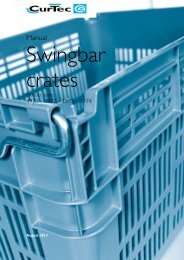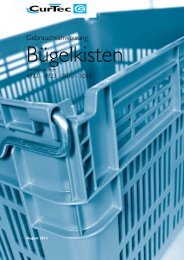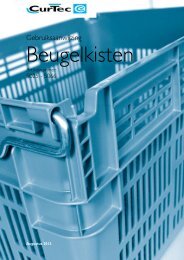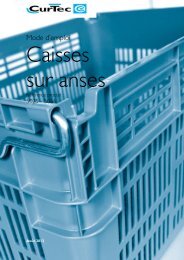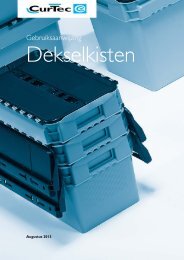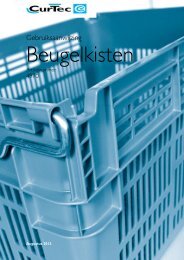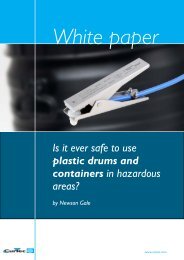Click Pack
Click Pack - CurTec
Click Pack - CurTec
Create successful ePaper yourself
Turn your PDF publications into a flip-book with our unique Google optimized e-Paper software.
04 Static loadWhen stacking the <strong>Click</strong> <strong>Pack</strong>s for storage in e.g. a warehouse orcold store it is important to know what the maximum stacking loadcan be on the bottom container. The stacking load depends stronglyon: the container weight, the number of containers to be stacked,the weight of interlayers and pallets, surrounding temperature, theduration of the load and the surface beneath the bottom containers.T (°C) t (months)Product code4406 4415 4420 4515 4520 45250 0,5 288 329 329 315 315 3150 2 242 277 277 285 285 2850 6 221 241 241 265 265 2650 12 193 221 221 240 240 24015 0,5 187 214 214 240 240 24015 2 157 180 180 220 220 22015 6 137 157 157 205 205 20515 12 126 144 144 190 190 19025 0,5 140 160 160 200 200 20025 2 118 135 135 185 185 18525 6 103 117 117 165 165 16525 12 95 108 108 150 150 15035 0,5 105 120 120 165 165 16535 2 95 101 101 150 150 15035 6 77 88 88 120 120 120The table shows for each <strong>Click</strong> <strong>Pack</strong> the maximum stacking load (inkg) at a given surrounding temperature during a certain period oftime placed on a flat and closed surface or pallet.Attention! The loads mentioned in the table can only serve as indications.CurTec always advises its customers to perform additional testing.On the basis of the table the number of containers that may bestacked can be calculated. It is the stacking load mentioned reducedby the carrying part of the pallet’s interlayers, divided by thecontainer weight. This number, with figures behind the commasmaller than eight, rounded off + 1 = total number of <strong>Click</strong> <strong>Pack</strong>s.<strong>Click</strong> <strong>Pack</strong> manual 1404



